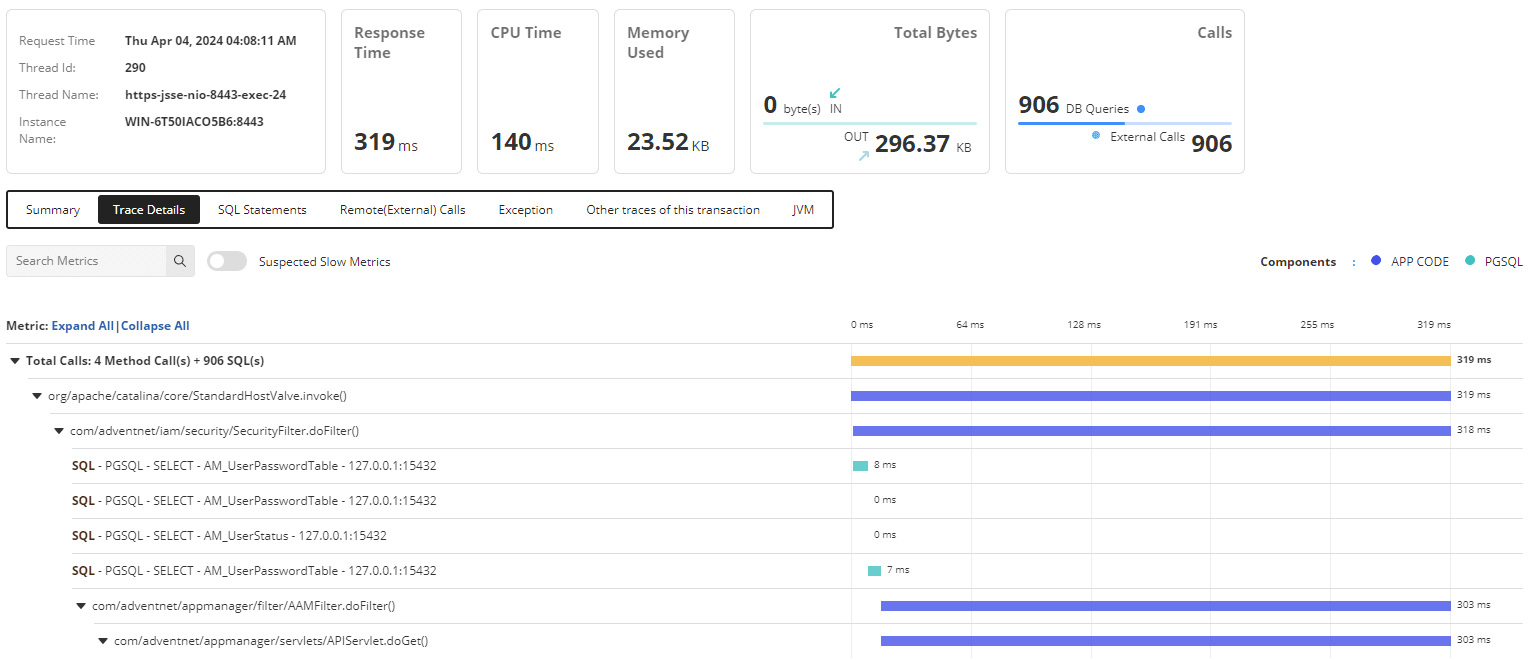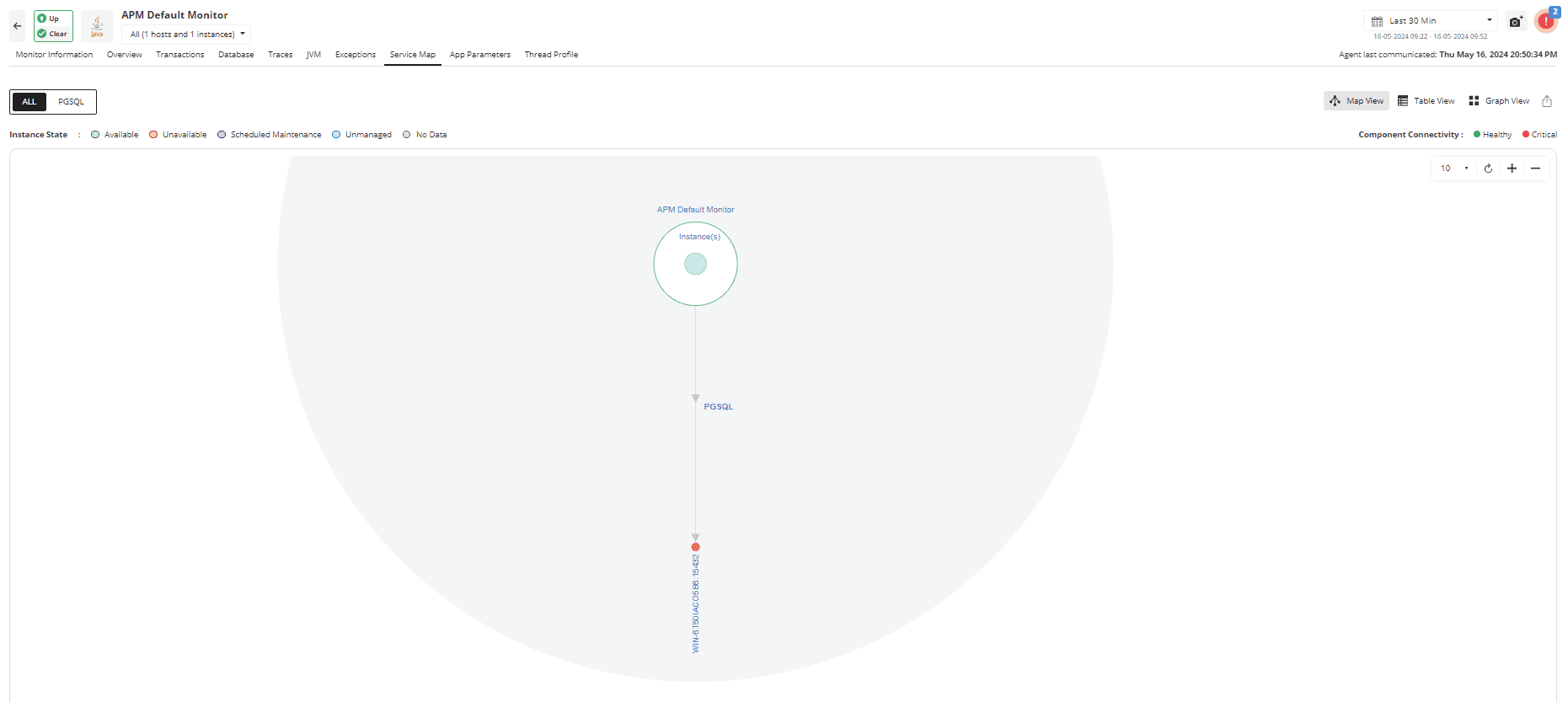Visualizing and understanding the complex and dynamic nature of microservices can be difficult, especially in distributed environments. As a result, you may find yourself with blind spots when performance issues arise. This lack of visibility makes it hard to diagnose issues, increases downtime and frustrates end users, and can potentially affect your company's reputation.
Monitoring microservices with Applications Manager enables you to gain comprehensive visibility into your microservices environment and discover how services interact with each other. This enables you to quickly identify performance issues and anomalies, and start troubleshooting quickly. Ensure seamless performance of your microservices ecosystem, minimize disruptions, and maximize user satisfaction.
Since microservices comprises a multitude of services working together to perform a business function, it is important to keep a constant watch on how individual services are performing, all within a single pane of glass. Microservices monitoring tools like Applications Manager facilitate you in obtaining deep visibility into your microservices architecture with the help of the below capabilities:
Containers play a major role in deploying applications in a microservices management platform. Since containerized applications interact with each other in a microservices infrastructure, monitoring microservices in these environments becomes crucial to ensuring smooth business operations.
Applications Manager's microservices monitoring tool enables you to obtain in-depth insights into your containerized microservice architecture. It keeps a constant watch on the critical KPIs of your Docker, Kubernetes, and OpenShift container orchestration platforms and monitors the performance of server health, nodes, pods, and services in your container platforms. It enables you to identify affected container nodes that are functioning abnormally , enabling youto find the root cause and take necessary steps to resolve issues at the earliest for a smooth functioning of services in your microservice architecture.
Learn more about container monitoring →
In a microservices management setup, requests flow from one service to another for communication and data transfer to perform required business operations. Since multiple requests navigate through various services, tracking the performance of individual request calls becomes important for key business transactions to get a clear idea of how your application is performing and to quickly troubleshoot performance issues.
With the help of Applications Manager's microservices monitoring dashboard, you can monitor the performance of transactions flowing between various services in your microservices environment. It tracks transactions calls performed from one service to another across platforms/languages, and helps you to minimize latency and enables you to quickly troubleshoot and resolve performance issues as soon as they arise at the transaction level with high accuracy and precision. As a result, you can easily identify the affected service in case of an error and work together with the relevant teams to resolve it quickly.
Learn more about distributed tracing →

Applications Manager's automated service maps visualizes the connections and dependencies of your application, making it easier to understand the complex interactions between services. It improves debugging and troubleshooting, helps with impact analysis, and helps teams plan and allocate resources better.
Learn more about service maps →

Since microservices monitoring best practices involve utilizing various services to interact with each other and perform business operations, many organizations opt for cloud platforms to deploy services instantly. As cloud platforms are known for their high availability, reliability, and security, and support various services for different business functionality, organizations across the globe find it easy to implement cloud services into their microservices environments. However, this increases the complexity of maintaining the service deployments and makes it painful for DevOps admins to identify and resolve issues arising from them.
With Applications Manager's microservices monitor, you can obtain complete end-to-end visibility into the services hosted across public, private, and hybrid clouds in your infrastructure. It provides microservice monitoring dashboard into the health and performance of your cloud instances that are hosting your microservices, measures system interactions across various cloud instances, and instantly notifies you whenever any cloud instance hosting your services goes down.
Learn more about cloud monitoring →
A microservices infrastructure interacts with a multitude of services altogether in the form of communication calls to perform a specific business operation. Since numerous communication calls are performed between services in a microservices infrastructure, ensuring proper communication management becomes necessary for proper functioning and data transfer between services. Service mesh platform is important to ensure proper routing of inter-service communication in a microservices infrastructure.
Microservices monitoring tools like Applications Manager allow you to keep a close watch on the performance of your Istio service mesh and ensure proper communication between various microservices in your infrastructure. It helps you to track the mesh traffic between microservices by providing in-depth insights into individual Istio components like Envoy, Pilot, Citadel, Galley, Mixer and alerts you whenever there's any abnormality in traffic routing between microservices. This helps you troubleshoot the exact issue and take necessary steps to ensure seamless communication between microservices.
Learn more about Istio monitoring →
With the help of AI-based alerting capabilities from Applications Manager, you can detect and resolve issues by identifying potential performance issues in your microservices infrastructure. You can make use of ML-based reporting to forecast how your microservices would be performing in the future based on performance trends of the last few months. Leveraging the power of AI-based alerting and reporting can aid you in easing the burden of performance tracking and incident troubleshooting and can help you to ensure that your microservices infrastructure is up and running without any hassles.

Microservices monitoring involves monitoring the performance of individual services that are running within a microservices infrastructure. It enables you to provide deep insights into how each and every service is functioning and interacting with each other and alerts you whenever any service is malfunctioning along with the exact root cause analysis of the component causing the issue in the service. This enables organizations to take appropriate measures to resolve issues faster.
Microservices architecture is one of the most sought-after technologies to be adapted by businesses in today's age. Known for its high availability, scalability, and fault tolerant capabilities, many organizations have migrated from monolithic to microservices architecture. It plays a crucial role in business operations that require high performance, such as banking, ecommerce, live streaming platforms, gaming, and more.
While it is true that the microservices architecture is broken up into multiple services for enhanced performance, easy management, and fault resolution, constantly maintaining those services individually and protecting them from unexpected malfunctions or downtime becomes difficult to handle in the long run. In case of issues with one of the services of their application, it becomes crucial for admins to know which service is causing the issue, finding out the root cause and resolving them at the earliest becomes vital to restore the operations back to normal.
To ensure your applications are up and running without any issues, keeping a constant watch on individual services that are involved in the functioning of those operations becomes crucial for seamless service delivery. To achieve this, having a robust microservices monitoring system in places becomes necessary.
Following are the challenges that are observed while monitoring microservices environments:
To effectively monitor microservices, ensure end-to-end visibility across services using distributed tracing, service maps, and container monitoring. Monitor key metrics like latency, throughput, and error rates at the service level. Set up real-time alerts to detect anomalies early, and leverage AI-powered insights to identify patterns and prevent performance bottlenecks. Integrating logs, metrics, and traces can also enhance observability and speed up troubleshooting.
ManageEngine Applications Manager monitors microservices by collecting real-time telemetry data—metrics, logs, and traces—from containers, cloud platforms, and services. It maps service dependencies automatically, tracks distributed transactions across services, and uses AI-powered alerts to detect anomalies. With deep insights into each service’s performance, the tool helps you quickly identify root causes, ensure high availability, and maintain a healthy microservices ecosystem.
Microservices monitoring tools like Applications Manager make it possible to perform microservices architecture monitoring without the need of external agents. To monitor microservices:
It allows us to track crucial metrics such as response times, resource utilization, error rates, and transaction performance. The real-time monitoring alerts promptly notify us of any issues or anomalies, enabling us to take immediate action.
Reviewer Role: Research and Development
Trusted by over 6000+ businesses globally